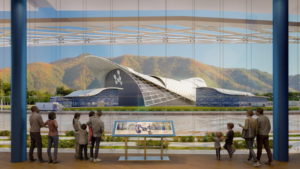by World Nuclear News, September 1, 2020
The US Nuclear Regulatory Commission (NRC) has issued a final safety evaluation report (FSER) for NuScale’s small modular reactor. This is the first-ever FSER to be issued by the NRC for an SMR, and represents the completion of the technical review and approval of the design.
…

….
The NuScale design uses passive processes such as convection and gravity in its operating systems and safety features to produce about 600 MW of electricity. Twelve modules, each producing 50 MW, are submerged in a safety-related pool built below ground level. The NRC has concluded the design’s passive features “will ensure the nuclear power plant would shut down safely and remain safe under emergency conditions, if necessary”, it said. NuScale has also indicated to NRC it will apply for standard design approval of a version using 60 MW modules, the regulator said. This would require additional NRC review.
…
by Donna Laframboise, September 2, 2020 in BigPicturesNews
Poll sponsors say climate attitudes have been ‘remarkably consistent’ over two decades.
A few days ago, Scientific American reprinted an article straight from Climatewire. Titled Republican Convention Ignored Climate Threat, But Americans’ Attitudes Are Shifting, it says “Polling shows that voter concern about climate change has been growing for years and that it has not diminished as a result of the coronavirus pandemic.” We’re then told about a recent public opinion survey affiliated with Stanford University.
…
…
by N. Thorner, October 25, 2019 in ClimateChangeDispatch
If you believe the debate over global warming has ever been about science—or for that matter climate—you have been conditioned, through formal education or through reports warning of doom and gloom, to believe what others rightly describe as a world-wide hoax concocted to unite the world under a single socialistic government where there is no capitalism, no democracy, and no freedom.
Why is exposing the truth so important? Because it has everything to do with the redistribution of wealth and the establishment of political agendas aimed at destroying the foundation of eastern democracies and free markets.
Accordingly, it is therefore critical for everyone to become informed so free and open debate can exist, rather than the suppression and falsification of actual scientific climate data.
This article will expose some of the popular climate myths about CO2, so the reader will be equipped with ammunition to spread the truth to those who are willing to listen and have not yet become environmental extremists.
Links are included after each myth to substantiate information and to provide reference material for further interest and clarification.
The article was written using individual articles, with permission from my friend Jay Lehr, Ph.D., in which he exposed popular climate myths related to CO2. Jay Lehr is a Senior Policy Analyst for The International Climate Science Coalition.
Myth #1: Carbon dioxide emissions cause catastrophic global warming.
…
by University of Leeds, September 1, 2020 in WUWT/Nature
Ice sheets in Greenland and Antarctica whose melting rates are rapidly increasing have raised the global sea level by 1.8cm since the 1990s, and are matching the Intergovernmental Panel on Climate Change’s worst-case climate warming scenarios.
…
…
So far, global sea levels have increased in the most part through a mechanism called thermal expansion, which means that volume of seawater expands as it gets warmer. But in the last five years, ice melt from the ice sheets and mountain glaciers has overtaken global warming as the main cause of rising sea levels.
Dr Ruth Mottram, study co-author and climate researcher at the Danish Meteorological Institute, said: “It is not only Antarctica and Greenland that are causing the water to rise. In recent years, thousands of smaller glaciers have begun to melt or disappear altogether, as we saw with the glacier Ok in Iceland, which was declared “dead” in 2014. This means that melting of ice has now taken over as the main contributor of sea level rise. “
###
Further information
The study, “Ice-sheet losses track high-end sea-level rise projections,” is published today (31 August) in Nature Climate Change.

View towards Icefjord in Ilulissat. Easy hiking route to the famous Kangia glacier in Greenland. The Ilulissat Icefjord seen from the viewpoint. Declared a UNESCO World Heritage Site in 2004. Photo taken in Greenland.
La géologie, une science plus que passionnante … et diverse


